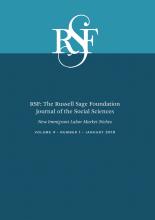Research Article
Open Access
Learning to Fill the Labor Niche: Filipino Nursing Graduates and the Risk of the Migration Trap
Yasmin Y. Ortiga
RSF: The Russell Sage Foundation Journal of the Social Sciences January 2018, 4 (1) 172-187; DOI: https://doi.org/10.7758/RSF.2018.4.1.10
Yasmin Y. Ortiga
aLecturer at the College of Alice and Peter Tan, University Town, National University of Singapore

REFERENCES
- ↵
- Acacio, Kristel
- ↵Acacio, Kristel. 2011. “Getting Nurses Here: Migration Industry and the Business of Connecting Philippine-Educated Nurses with United States Employers.” PhD diss., University of California, Berkeley.
- ↵
- Aiken, Linda H
- ↵
- Aiken, Linda H.,
- Robyn B. Cheung, , and
- Danielle M. Olds
- ↵Arum, Richard, and Josipa Roksa. 2011. Academically Adrift: Limited Learning on College Campuses. Chicago: University of Chicago Press.
- ↵Asis, Maruja M. B. 2006. “The Philippines’ Culture of Migration.” Washington, D.C.: Migration Policy Institute (January 1). Available at: http://www.migrationpolicy.org/article/philippines-culture-migration/ (accessed June 29, 2016).
- ↵Asis, Maruja M. B., and Graziano Batistella. 2013. The Filipino Youth and the Employment Migration Nexus. Philippines: UNICEF Philippines.
- ↵Bagaoisan, Andrew Jonathan, and Mark Angelo Ching. 2009. “Defying CHED Rules, Substandard Nursing Schools Churn Out Graduates.” GMANewsOnline, June 16. Available at: http://www.gmanetwork.com/news/story/165082/news/specialreports/defying-ched-rules-substandard-nursing-schools-churn-out-graduates (accessed June 29, 2016).
- ↵
- Brooks, Rachel, and
- Glyn Everett
- ↵
- ↵Brown, Phillip, and Anthony Hesketh. 2004. The Mismanagement of Talent: Employability and Jobs in the Knowledge Economy. New York: Oxford University Press.
- ↵Brown, Phillip, Hugh Lauder, and David Ashton. 2011. The Global Auction: The Broken Promises of Education, Jobs, and Incomes. Oxford: Oxford University Press.
- ↵
- ↵
- Brush, Barbara L
- ↵
- Brush, Barbara L., and
- Anne M. Berger
- ↵
- ↵
- ↵Buchan, James, Mireille Kingma, and F. Marilyn Lorenzo. 2005. “International Migration of Nurses: Trends and Policy Implications.” Geneva, Switzerland: International Council of Nurses, Global Nursing Review Initiative.
- ↵
- ↵
- Buerhaus, Peter I.,
- David I. Auerbach, , and
- Douglas O. Staige
- ↵
- ↵Choy, Catherine Ceniza. 2003. Empire of Care: Nursing and Migration in Filipino American History. Durham, N.C.: Duke University Press.
- ↵
- Cortés, Patricia, and
- Jessica Pan
- ↵
- Cortés, Patricia, and
- Jessica Pan
- ↵
- Creighton, Mathew,
- Hyunjoon Park, , and
- Graciela Teruel
- ↵
- Csedo, Krisztina
- ↵
- De Haas, Hein
- ↵
- ↵
- Gamil, Jaymee T
- ↵George, Sheba Mariam. 2005. When Women Come First: Gender and Class in Transnational Migration. Berkeley: University of California Press.
- ↵
- Glaessel-Brown, Eleanor E
- ↵
- Goodin, Heather J
- ↵Gordon, Suzanne. 2005. Nursing Against the Odds: How Health Care Cost Cutting, Media Stereotypes, and Medical Hubris Undermine Nurses and Patient Care. Ithaca, N.Y.: Cornell University Press.
- ↵
- Goss, Jon, and
- Bruce Lindquist
- ↵Guevarra, Anna Romina. 2010. Marketing Dreams, Manufacturing Heroes: The Transnational Labor Brokering of Filipino Workers. Piscataway, N.J.: Rutgers University Press.
- ↵International Centre on Nurse Migration (ICNM). 2012. “The Impact of the Financial Crisis on Nurses and Nursing: A Comparative Overview of 34 European Countries.” ICNM News. Geneva, Switzerland: International Council of Nurses.
- ↵International Council of Nurses (ICN). 2006. The Global Nursing Shortage: Priority Areas for Intervention. Geneva, Switzerland: ICN.
- ↵
- Jimenez-David, Rina
- ↵
- Kalleberg, Arne
- ↵
- Keuhn, Bridget M
- ↵
- Kingma, Mireille
- ↵
- Kingma, Mireille
- ↵
- ↵
- Kofman, Eleonore
- ↵
- Lorenzo, Fely Marilyn E.,
- Jaime Galvez-Tan, ,
- Kriselle Icamina, , and
- Lara Javier
- ↵Martin, Philip. 2012. “Reducing Migration Costs and Maximizing Human Development.” In Global Perspectives on Migration and Development: GFMD Puerto Vallarta and Beyond, edited by Irene Omelaniuk. New York: Springer.
- ↵
- Masselink, Leah E., and
- Shoou-Yih Daniel Lee
- ↵
- McKenzie, David, and
- Hillel Rapoport
- ↵
- ↵
- Nobles, Jenna
- ↵
- Ortiga, Yasmin Y
- ↵
- ↵
- Pazzibugan, Dona Z
- ↵Philippine Commission on Higher Education (CHED). 2016. “Higher Education in Numbers.” Last modified June 1, 2016. Available at: http://ched.gov.ph/central/page/higher-education-data-infographics-2016 (accessed May 23, 2017).
- Philippine Overseas Employment Agency (POEA). 2015. “OFW Statistics.” Available at: http://www.poea.gov.ph/ofwstat/ofwstat.html (accessed May 24, 2017).
- ↵
- Polsky, Daniel,
- Sara J. Ross, ,
- Barbara L. Brush, , and
- Julie Sochalski
- ↵
- Portes, Alejandro,
- Patricia Fernandez-Kelly, , and
- William J. Haller
- ↵
- ↵
- ↵Rodriguez, Robyn M. 2010. Migrants for Export: How the Philippine State Brokers Labor to the World. Minneapolis: University of Minnesota Press.
- ↵
- Rodriguez, Robyn M., and
- Helen Schwenken
- ↵
- Rother, John, and
- Risa Lavizzo-Mourey
- ↵
- Smith, Vicki
- ↵Tan, Edita. 2009. Supply Response of Filipino Workers to World Demand. Philippines: International Organization of Migration.
- ↵
- ↵
- Uy, Jocelyn
- ↵
- Yang, Dean
- ↵
- Yeates, Nicola
- ↵
In this issue
Learning to Fill the Labor Niche: Filipino Nursing Graduates and the Risk of the Migration Trap
Yasmin Y. Ortiga
RSF: The Russell Sage Foundation Journal of the Social Sciences Jan 2018, 4 (1) 172-187; DOI: 10.7758/RSF.2018.4.1.10
Jump to section
Related Articles
- No related articles found.
Cited By...
- No citing articles found.









